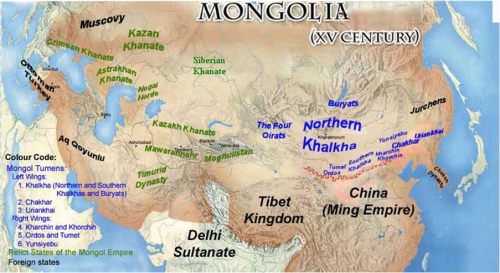peashooter85:Judgement at KarakorumThe death of Mongke Khan in 1259 brought the end of the Mongol Em
peashooter85:Judgement at KarakorumThe death of Mongke Khan in 1259 brought the end of the Mongol Empire. Perhaps what made the Mongols most successful as conquerors was their unity, a unity which was always tenuous at best. When Mongke Khan died he left no heirs to take over the empire, and as a result the Mongol Empire fractured between many khans and warlords. The largest and most powerful Mongol state that resulted was the Yuan Dynasty, founded in 1271 by Kublai Khan, which controlled all of China, Mongolia, Korea, parts of Siberia, and parts of Central Asia. The Yuan Dynasty didn’t even last a hundred years before collapsing, showing that while the Mongols were great empire conquerors and empire builders, they were not very good empire keepers. The Yuan Emperors created a class system with the Mongols at the top, controlling all high level government and military positions. The native Chinese were relegated to second class status within their own country, which fomented resentment against the Mongols. Furthermore, the Mongols of the Yuan Dynasty were terrible administrators, and over the decades the Chinese economy collapsed due to economic and financial mismanagement. The countryside was ravaged by outlaws and criminals. Corruption was rampant, as was political intrigue. Like I mentioned before, what made the Mongols most powerful was their unity. Without unity, the Mongols were nothing more than small bands of marauders and brigands. Infighting was common among the Mongols as heirs of Kublai Khan fought for control of the empire. The Yuan Mongols themselves were not the same Mongols bred during the days of Genghis Khan. Rather than being fierce and ruthless steppe warriors, decades of luxurious living and wealth had transformed the Mongols into a horde of overprivileged brats who needed a good ass whoopin’ for their own good.By the 1350′s, Chinese hatred of the Mongols had reached the boiling point. The Mongols ruled under the Mandate of Heaven, an ancient Chinese doctrine that said that rulers governed with the blessings of the gods. However, the gods could withdraw their mandate, giving the people the right to overthrow an incompetent or tyrannical ruler. Heaven would give a sign that it had withdrawn it’s mandate with a series of natural disasters. In the 1350′s China was plagued with a number of disastrous floods, droughts, and famines, disasters which a weakened Mongol government could do little to mitigate. To the Chinese, the Mongols were both incompetent and tyrannical, it was time for them to be tarred, feathered, and run out of town on a rail.In 1351, a religious political movement called the White Lotus Society founded the Red Turban Rebellion, a movement to kick the Mongols out of China once and for all. The Mongols were almost powerless to stop them as millions across China rose up in arms. While the Mongols were extraordinary conquerors, the sucked at defending and holding ground. Back in the days before Genghis Khan, if the Chinese sent a massive army into Mongolia to quell the tribes, the Mongols would simply pack up their yurts and bug out, disappearing into the vastness of the steppes. Now that they had to defend an empire and hold on to territory, they had lost the advantage of mobility. The Mongols were not prepared to deal with such a mass uprising. Over the next seven years the Mongols were forced to retreat toward the north, until in 1358 the last Yuan Emperor, Toghon Temur, ordered a complete withdrawal from China. The Mongols would found a rump state called the Northern Yuan Dynasty in Mongolia, while a Red Turban leader named Zhu Yuanzhang claimed the Mandate of Heaven and founded the Ming Dynasty. The Ming Chinese continued to advance against the Mongols, driving father north and eventually kicking the Mongols out of Manchuria. In 1388 the Ming invaded Mongolia with a massive army. The Mongols attempted to stop them, but were easily crushed at the Battle of Lake Biur, which resulted in 70,000 Mongols surrendering to the Chinese Imperial Army. The Ming then marched on the Mongol capital of Karakorum, and burned it to the ground. Talk about comeuppance.After the destruction of Karakorum, the Mongols reverted back into their old tribal ways, splitting into factions that remained in almost constant civil war. The Ming watched closely, and whenever it seemed that a leader would emerge to unite the Mongols once again, the Ming would invade, cut that person down to size, and the infighting among the Mongols would begin again. As a result, the Mongols would never be the existential threat to China or any other civilization like they were back in the days of Genghis Khan. Some came close to bringing back old Mongol glory, such as in 1449 when the Mongols defeated a 500,000 man Ming army, captured the emperor, and laid siege to Beijing, but Mongol infighting destroyed the offensive and regressed the Mongols back to their old ways once again. In 1757, the Manchu Dynasty conquered Mongolia, reducing the Mongol population by 80% through warfare, disease, and genocide. In the meantime, the Russians advanced from the west, conquering and occupying traditional Mongol lands in Central Asia.Mongolia would remain a province of Manchu China until the fall of the Dynasty in 1912. In 1924 Mongolia became a communist state under the Mongolian People’s Republic. While technically Mongolia was a sovereign nation, in reality it was a puppet state of the Soviet Union, who occupied the country with Red Army troops up until the end of World War II. As a result, around 30,000 Mongolians were executed as part of Stalin’s purges in the late 1930′s. After World War II Mongolia would become a pawn of the Soviet Union in it’s Cold War squabbles against China. Communism came to an end in Mongolia as the Soviet Union collapsed. -- source link

